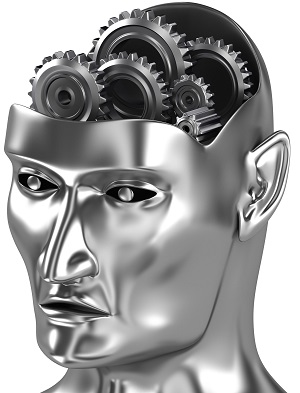30 Dec Aristotle and von Neumann
 In the 1950’s, John von Neumann compared the computer to the brain. Scientific inquiry that laid the foundation for that comparison, however, had begun long before. The influence of the Greek philosopher Aristotle’s association theory (metaphysics), for example, is evident in neural net theory. In The Computer and the Brain, Dr. von Neumann describes how computers’ memories resemble neurons. “Systems of nerve cells,” he writes, “which stimulate each other in various possible cyclical ways, also constitute memories. These would be memories made up of active elements (nerve cells). In our computing machine technology, such memories are in frequent and significant use” [1958, p. 66].
In the 1950’s, John von Neumann compared the computer to the brain. Scientific inquiry that laid the foundation for that comparison, however, had begun long before. The influence of the Greek philosopher Aristotle’s association theory (metaphysics), for example, is evident in neural net theory. In The Computer and the Brain, Dr. von Neumann describes how computers’ memories resemble neurons. “Systems of nerve cells,” he writes, “which stimulate each other in various possible cyclical ways, also constitute memories. These would be memories made up of active elements (nerve cells). In our computing machine technology, such memories are in frequent and significant use” [1958, p. 66].
Yet he qualified his observation: “We do most emphatically not know what type of physical entities are the basic components of [human] memory” [ibid, p. 68]. Incidentally, we also don’t yet know how memory works, how we load it with information, or how we access it. Shall We Go On? If we don’t know much about human memory, how can we proceed with this study?
In a computer, memory-access tasks like storing and accessing information are fairly basic. The hard part comes when results need to be computed. Is it safe to presume that the human brain works the same way? Is memory simple and thinking hard? Certainly we could argue that performing recognition tasks that are strictly memory related is far easier than cognitive processing, such as making decisions about future actions.
| Understanding Context Cross-Reference |
|---|
| Click on these Links to other posts and glossary/bibliography references |
|
|
|
| Prior Post | Next Post |
| Context Models | Signal Transduction in Neurons |
| Definitions | References |
| computer brain | von Neumann 1958 |
| association neural net | Aristotle |
| memory recognition | Bartlett 1932 |
| information processing knowledge |
The bottom line is this: we have learned much about memory since the days of von Neumann — more than enough, in fact, to proceed with this study. This will become more apparent in Sections 4 and 5, which look in depth at the more complex cognitive activities of human memory.

Mechanical Brains
What is the mechanical brain paradigm?
Scientists have developed excellent information processing tools (computers) that extend our ability to retain, access, and use the enormous and ever-growing body of knowledge we possess. These computers are designed on the basis of a combination of mechanical principles and automata theory. The combined processes are called artificial intelligence (AI).
Automata theory is a set of principles used to manipulate symbols to produce desired results. Manipulating ones and zeros as symbols is how all computers process information. It is likely that human brains also manipulate symbols, such as words and images, to store and process knowledge. An analogy can thus be drawn between automata theory and cognitive science. The extension of this analogy is to treat computers as mechanical devices that imitate some cognitive processes. A simplification of this analogy is to call computers mechanical brains.
Controversy? Expressions such as “mechanical brain” and “artificial intelligence” used to excite controversy. After all, they raise serious philosophical and even theological questions. The potential (and potential danger) of developing genuine “thinking” machines has been romantically portrayed in many works, including 2001 — A Space Odyssey. The theme song of that movie, “Thus Spake Zoroaster,” reflects the personification or deification of the machine or its maker (creator).
I do not intend to examine the likelihood of technology ever reaching the complex level of biological systems (artificial life). Instead, my intelligent systems architecture uses nature as a model to improve functional approaches to mechanical problem solving. My modest goal is to make people’s lives better by automating difficult tasks, including language translation, that require advanced intelligence.
| Click below to look in each Understanding Context section |
|---|








